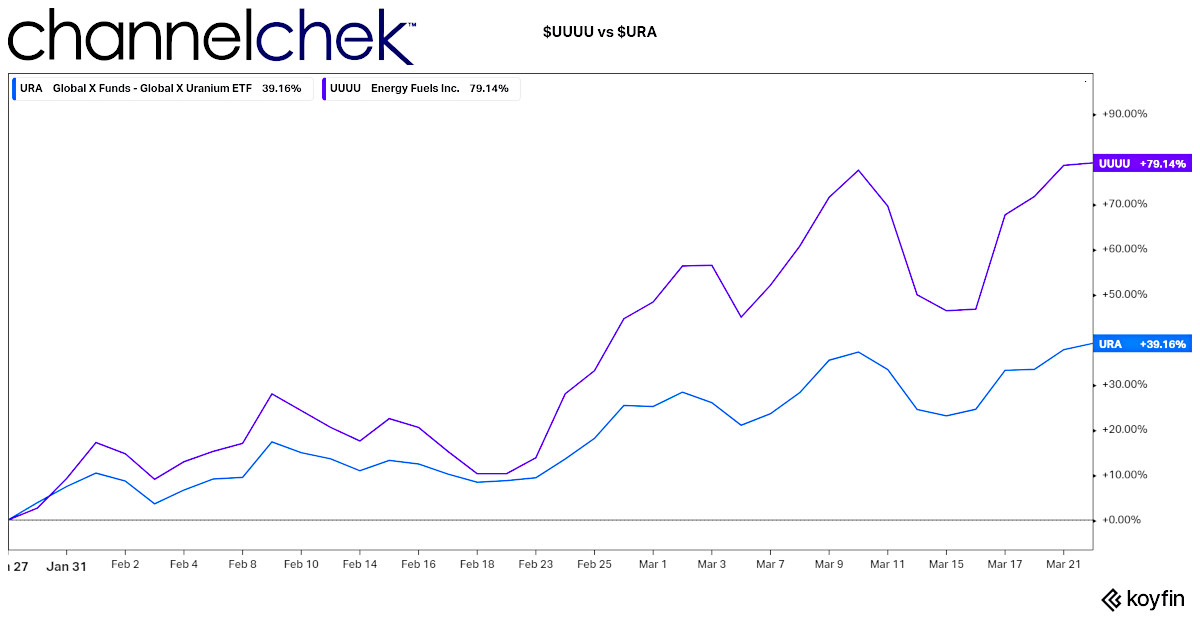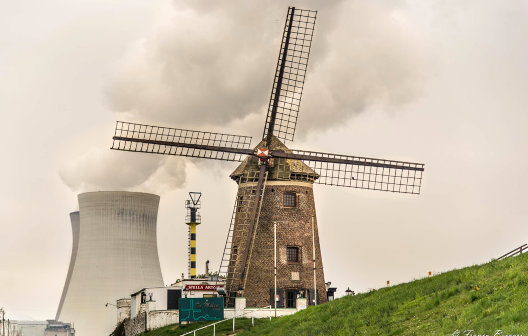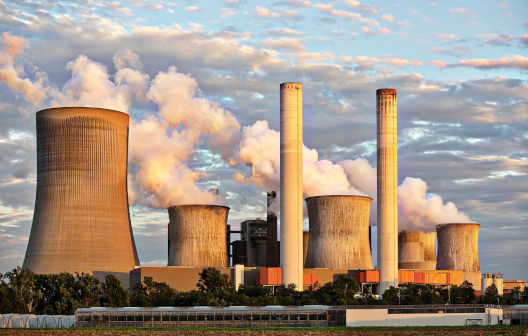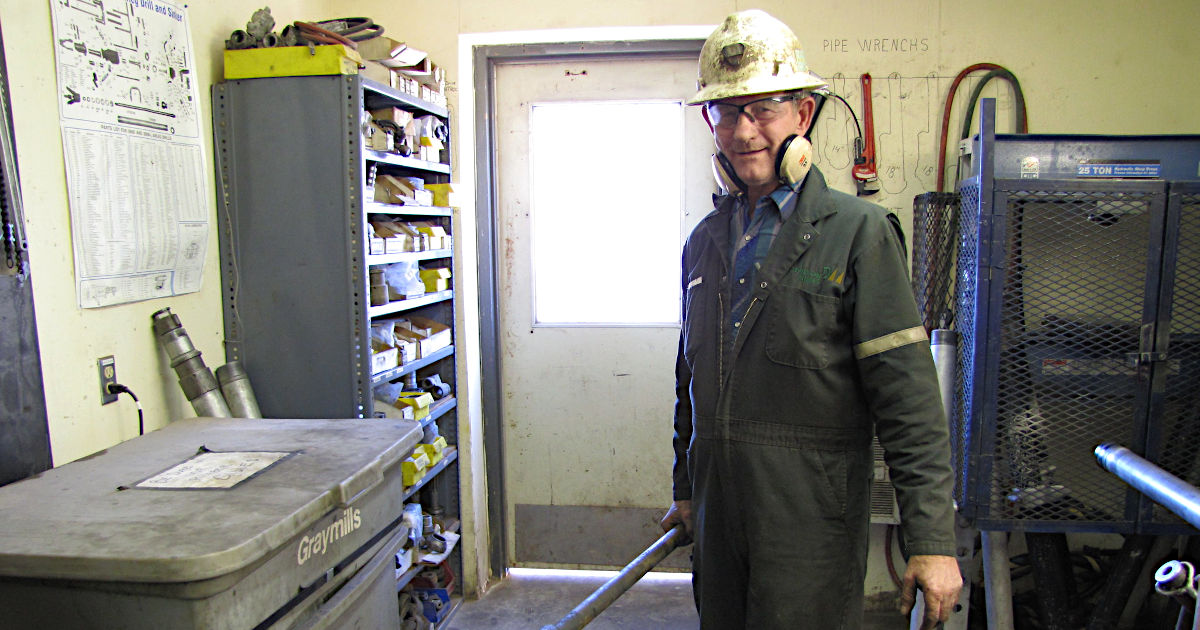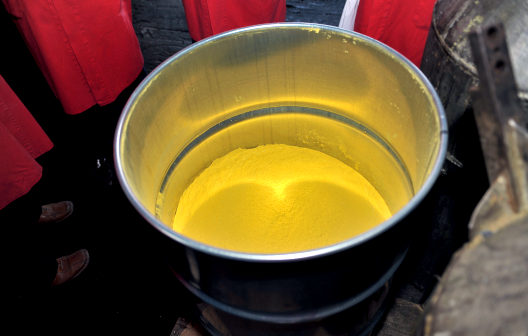
Energy Fuels Announces 2021 Results, Including Net Profits, Strong Cash Position, and Market-Leading U.S. Uranium, Rare Earth and Vanadium Position
Research, News, and Market Data on Energy Fuels
LAKEWOOD, Colo., March 15, 2022 /CNW/ – Energy Fuels Inc. (NYSE American: UUUU) (TSX: EFR) (“Energy Fuels” or the “Company”) today reported its financial results for the year ended December 31, 2021. The Company’s annual report on Form 10-K has been filed with the U.S. Securities and Exchange Commission (“SEC“) and may be viewed on the Electronic Document Gathering and Retrieval System (“EDGAR“) at www.sec.gov/edgar.shtml, on the System for Electronic Document Analysis and Retrieval (“SEDAR“) at www.sedar.com, and on the Company’s website at www.energyfuels.com. Unless noted otherwise, all dollar amounts are in U.S. dollars.
Highlights:
- Energy Fuels reported a net income of $1.5 million for 2021.
- At December 31, 2021, the Company had a robust balance sheet with $143.2 million of working capital, including $113.0 million of cash and marketable securities, $30.8 million of inventory, and no short term (or long term) debt. At current commodity prices, the Company’s December 31, 2021 product inventory would have a value of approximately $60.6 million.
- During 2021, prices for all the commodities Energy Fuels produces, or has the ability to produce, rose significantly. Uranium oxide (“U3O8“) prices increased approximately 38%, neodymium-praseodymium oxide (“NdPr“) prices increased approximately 112%, and vanadium oxide (“V2O5“) prices increased approximately 62%. Prices for each of these commodities have continued to show significant strength to date in 2022. The Company continues to closely follow developments related to Russia’s invasion of Ukraine, as Russia is a major supplier of uranium and nuclear fuel to U.S. and European customers. Prices of uranium have risen sharply in recent days.
- While the Company chose to not sell any uranium during 2021, it is now actively engaged in pursuing selective long-term uranium sales contracts.
- The Company produced approximately 270 metric tonnes of mixed rare earth element (“REE“) carbonate (“RE Carbonate“), containing 120 metric tonnes of total rare earth oxides (“TREO“) during 2021, as it commenced ramping up its REE recovery infrastructure. Energy Fuels’ RE Carbonate is the most advanced REE material being produced in the U.S. today.
- The Company is currently in active discussions with several sources of natural monazite sands around the world to significantly increase the supply of feed for its growing REE initiative.
- During Q1-2022, the Company began commercially separating Lanthanum (La) and Cerium (Ce) on a small scale from its RE Carbonate, using an existing solvent extraction circuit at the Mill. This represents the first commercial level REE separation to occur in the U.S. in many years.
- The Company is planning to install a full separation circuit at its White Mesa Mill (the “Mill“) to produce both “light” and “heavy” separated REE oxides in the coming years, subject to successful licensing, financing, and commissioning, and continued strong market conditions. The Company has hired Carester SAS (“Carester“), a global leader in producing separated REE oxides, to support these REE separation initiatives.
- On December 15, 2021, the Company announced a strategic venture with Nanoscale Powders LLC (“NSP“) for the development of a novel technology that would potentially produce REE metals. The technology has the potential to reduce the costs of production, energy consumption, and greenhouse gas emissions versus existing technologies.
- In 2021, the Company sold small quantities of its existing V2O5 inventory to capitalize on recent market strength. The Company expects to continue to sell vanadium as prices increase and is evaluating the potential to resume vanadium recovery at the Mill, where its tailings pond solutions contain an estimated additional 1.0 to 3.0 million recoverable pounds of V2O5.
- In July 2021, the Company announced the execution of a Strategic Alliance Agreement with RadTran, LLC to evaluate the potential recovery of thorium and radium from the Company’s existing RE Carbonate and uranium process streams for use in the production of medical isotopes for emerging targeted alpha therapy (“TAT“) cancer therapeutics. This initiative complements the Company’s existing uranium and RE Carbonate businesses, as it investigates the potential recovery of isotopes in existing process streams at the Mill for medical purposes.
- In September 2021, the Company announced its establishment of the San Juan County Clean Energy Foundation (the “Foundation“), a fund specifically designed to contribute to the communities surrounding the Mill in southeastern Utah by providing funding to support local economic development and local priorities.
- In October 2021, the Company completed the sale of certain, permitted non-core conventional uranium assets to Consolidated Uranium Inc. (“CUR”), including the Daneros mine, the Tony M mine, and the Rim mine. The Company reported a gain on the value of this transaction of $35.7 million, resulting in a significant improvement in the Company’s results of operations and net income for 2021.
- On January 25, 2022, the Board appointed Dr. Ivy Estabrooke as a Director of Energy Fuels, bringing to the Company experience in commercial-stage biotech, research and development program leadership, and technology solutions for national security and public health challenges.
Mark S. Chalmers, Energy Fuels’ President and CEO, stated:
“In 2021, we believe Energy Fuels further strengthened its position as America’s leading multi-commodity, critical mineral company, as we made excellent progress on our uranium, REEs, vanadium and medical isotope initiatives. We are deploying our ‘one-of-a-kind’ licenses, facilities, and expertise to responsibly recover the critical elements needed for carbon-free nuclear energy, electric vehicle powertrains, wind generation, advanced electronics, grid-scale batteries, other clean energy and advanced technologies, and potentially cancer therapeutics.
“We are particularly proud of our accomplishments in REEs. We announced our entry into the REE business less than two years ago, and today we are ramping up our production of commercial quantities of RE Carbonate, which is a more advanced REE material than any other U.S. company is producing, as we are chemically recovering the REEs in a high-purity material that is ready for REE separation. We are also moving toward licensing and installing the infrastructure needed to produce separated REE oxides on a full commercial scale in the coming years. The proven processing technology for producing separated REE oxides is solvent extraction, or ‘SX,’ and our White Mesa Mill has over 40 years of experience producing uranium and vanadium using SX. With the support of Carester, a leading global consultant in the production of separated REE products, we believe it is a logical ‘next step’ for Energy Fuels to produce separated REE oxides on a full commercial scale at the Mill. We have already successfully performed La, Ce, and NdPr separations at pilot scale in the Mill’s lab over the past several months, and we recently began ramping up our commercial separation of La and Ce from our RE Carbonate on a small scale using an existing SX circuit at the Mill. Our primary REE focuses in 2022 will be building our supply of monazite ore, designing and licensing a new full commercial scale REE separation circuit at the Mill, and advancing our innovative REE metal initiative with NSP.
“With the recent events in Ukraine, security of supply in the U.S. for uranium is crucial. Energy Fuels continues to be the leading low-cost U.S. uranium producer with more production facilities and capacity than any other U.S. company, and we stand ready to be a reliable, large-scale supplier to U.S. nuclear utilities. We are seeing an increase in utility interest for long-term contracts. We are pursuing uranium sales contracts with pricing and terms that return acceptable project margins and maintain exposure to further uranium market upside.
“Vanadium prices are rising, as well. In 2019, we built a significant inventory of vanadium to sell into the abrupt upside price volatility that vanadium markets often experience, most recently in late 2018. The next upward cycle may have begun, as prices have risen sharply in the first months of 2022, and we are selling some of our inventory. As we sell, we will evaluate the potential to resume production from the Mill’s pond solutions or our conventional deposits to replace our sold inventory. We estimate our pond solutions alone contain another 1.0 to 3.0 million pounds of recoverable V2O5 and would be first and lowest cost to market.
“A few words on our medical isotope initiative. This is another area where we are able to deploy our unique facilities, licenses, and expertise to potentially help create a domestic supply chain for emerging cancer therapies. Recovering radioisotopes for use in cancer treatments from our existing process streams, thereby recycling valuable material that would otherwise be lost to direct disposal, would, if successful, be a great way to maximally use all of our feeds. And we would be accomplishing this in a way that is environmentally beneficial and highly congruent with Energy Fuels’ recycling and sustainability goals.
“We are also very pleased to announce that, on January 25, 2022 Dr. Ivy Estabrooke was appointed to the Board of Energy Fuels. Dr. Estabrooke brings to the Company an impressive background that is highly pertinent, not only to our new REE and TAT cancer therapeutics initiatives, but also to our core uranium business, which is of the utmost importance to national security at this time.”
Webcast at 1:00 pm EDT on March 17, 2022:
Energy Fuels will be hosting a video webcast on March 17, 2022 at 1:00 pm EDT (11:00 am MDT) to discuss its FY-2021 financial results, the outlook for 2022, uranium, rare earths, vanadium, and medical isotopes. To join the webcast and access the presentation and viewer-controlled webcast slides, please click on the link below:
Webcast Link
If you would like to participate in the webcast and ask questions, please dial in to 1-888-664-6392 (toll free in the U.S. and Canada).
A link to a recorded version of the proceedings will be available on the Company’s website shortly after the webcast by calling 1-888-390-0541 (toll free in the U.S. and Canada) and by entering the code 179864#. The recording will be available until March 31, 2022.
Selected Summary Financial Information:
|
|
|
|
|
$000’s, except per share data
|
Year ended
December 31, 2021
|
Year ended
December 31, 2020
|
Year ended
December 31, 2019
|
|
Total revenues
|
$
|
3,184
|
$
|
1,658
|
$
|
5,865
|
|
Gross profit (loss)
|
1,370
|
14
|
(12,433)
|
|
Operating profit (loss)
|
(35,425)
|
(24,627)
|
(40,581)
|
|
Net income (loss) attributable to the company
|
1,541
|
(27,776)
|
(37,978)
|
|
Basic and diluted net income (loss) per common share
|
0.01
|
(0.23)
|
(0.40)
|
|
|
|
|
$000’s
|
As at December 31,
2021
|
As at December 31,
2020
|
|
Financial Position:
|
|
|
|
Working capital
|
$
|
143,190
|
$
|
40,158
|
|
Property, plant and equipment, net
|
21,983
|
23,621
|
|
Mineral properties, net
|
83,539
|
83,539
|
|
Total assets
|
315,446
|
183,236
|
|
Total long-term liabilities
|
13,805
|
13,376
|
Financial Discussion:
At December 31, 2021, the Company had $143.2 million of working capital, including $113.0 million of cash and marketable securities and $30.8 million of inventory, including approximately 691,000 pounds of uranium and 1,650,000 pounds of vanadium, both in the form of immediately marketable product. The spot price of U3O8 at March 11, 2022 was $58.50 per pound, according to TradeTech (up from $42.00 per pound at December 31, 2021. The current mid-point spot price of V2O5 at March 11, 2022 was $12.25 per pound after remaining relatively flat near the 2021 year-end, according to FastMarkets. Based on today’s spot prices, the Company’s December 31, 2021 uranium and vanadium inventories would have a current market value of $40.4 million and $20.2 million, respectively, totaling approximately $60.6 million. On October 27, 2021, the Company completed the sale of certain non-core conventional assets to CUR. In addition to receiving $2 million cash at closing, the Company now holds 19.1% of the outstanding shares of CUR as of December 31, 2021, for a total value to the Company of $32.2 million as at December 31, 2021.
During the year ended December 31, 2021, the Company realized net income of $1.5 million, compared to a net loss of $27.9 for the year ended December 31, 2020. The net income in 2021 was primarily due to the sale of non-core conventional uranium assets to CUR. The Company spent $10.75 million for development of the Company’s properties, primarily due to the development and ramping up of the RE Carbonate production program at the Mill. The Company also incurred underutilized capacity production costs applicable to rare earth concentrates during the year of $0.53 million. The underutilized capacity production costs are due to low throughput rates as the Mill ramps-up to commercial-scale production at full capacity. To date, the Mill has focused on producing commercially salable RE Carbonate at low throughput rates and has been very pleased with the resulting product it is shipping for separation. The Mill expects to increase its throughput rates as its supplies of monazite sands increase. The Company is in advanced discussions with several additional sources of monazite sands that, if successfully secured, we expect to result in sufficient throughput to reduce underutilized capacity production costs and allow the Company to realize its expected margins on a continuous basis.
Rare Earth Achievements in 2021 and To Date in 2022:
On March 1, 2021, the Company and Neo Performance Materials Limited (“Neo“) announced a new rare earth production initiative spanning European and North American critical material supply chains. Under an agreement in principle signed on March 1, 2021 and finalized into a definitive agreement in July 2022, Energy Fuels will process natural monazite sands, currently being mined in the state of Georgia by The Chemours Company, into an RE Carbonate at the Mill and ship a portion of the produced RE Carbonate to Neo’s rare earth separations facility in Sillamäe, Estonia (“Silmet“). Silmet will then process the RE Carbonate into separated rare earth materials for use in rare earth permanent magnets and other rare earth-based advanced materials.
On July 7, 2021, the Company announced that the first container (approximately 20 tonnes of product) of an expected 15 containers of mixed RE Carbonate had been successfully produced by Energy Fuels at the Mill and was en route to Silmet. This commercial-scale production of RE Carbonate by Energy Fuels from a U.S. mined rare earth resource positions Energy Fuels as the only company in North America that currently produces a monazite-derived, enhanced rare earth material. The physical delivery of this product also represents the launch of a new, environmentally responsible rare earth supply chain that allows for source validation and tracking from mining through to final end-use applications for manufacturers in North America, Europe, Japan, and other nations.
The Company also announced on March 1, 2021 that, in addition to supplying RE Carbonate to Neo, Energy Fuels is evaluating the potential to develop U.S. separation capabilities at the Mill, or nearby, as it works to increase its monazite sand supplies, thereby fully integrating a U.S. rare earth supply chain in the coming years, in addition to supplying RE Carbonate to European markets. On April 27, 2021, the Company announced it had engaged Carester to prepare a scoping study for the development of a solvent extraction REE separation circuit at the Mill utilizing the Mill’s existing equipment and infrastructure to the extent applicable, to create a continuous, integrated and optimized rare earth production sequence. Based in Lyon, France, Carester is one of the world’s leading global consultants on rare earth supply chains, with expertise in designing, constructing, operating and optimizing REE production facilities globally. Carester’s scoping work included an evaluation of the Mill’s current monazite leaching process, preparation of an REE separation flow sheet, capital and operating expense estimates, incorporation of new technologies where applicable, and recommendations on equipment vendors. The Company is planning to install a full separation circuit at its White Mesa Mill to produce both “light” and “heavy” separated REE oxides in the coming years, subject to successful licensing, financing, and commissioning, and continued strong market conditions. The Company has hired Carester to perform a second scoping study to support these REE separation initiatives.
During Q1-2022, the Company began commercially separating La and Ce from its RE Carbonate on a small scale using an existing solvent extraction circuit at the Mill. This represents the first commercial level REE separation to occur in the U.S. in many years. The Company has been performing laboratory-scale REE separations for the last several months on a 24/7 basis, successfully executing the La, Ce, and NdPr separations at high-purities and with excellent recoveries.
On December 15, 2021, the Company announced the execution of an MOU with NSP for the development of a novel technology for the potential production of REE metals, subject to the finalization of definitive agreements. We believe this technology, which was initially developed by NSP, and will be advanced by the Company and NSP working together, has the potential to revolutionize the rare earth metal making industry by reducing costs of production, reducing energy consumption, and significantly reducing greenhouse gas emissions. Producing REE metals and alloys is a key step in a fully integrated REE supply chain, after production of separated REE oxides and before the manufacture of neodymium iron boron (“NdFeB“) magnets used in electric vehicles, wind generation and other clean energy and advanced technologies.
In addition, during 2022, the Company announced the execution of a non-binding memorandum of understanding (“MOU“) for the supply of natural monazite sands from IperionX Limited’s (“IperionX’s“, formerly known as Hyperion Metals Limited) Titan Project in Tennessee, if and when the project is developed and mined. IperionX’s Titan Project covers a large area of heavy mineral sands properties in Tennessee prospective for titanium, zircon, monazite and other valuable minerals such as high-grade silica sand and other refractory minerals.
In 2021, the Company also announced that the U.S. Department of Energy (“DOE“) Office of Fossil Energy and National Energy Technology Laboratory had exercised its option to award Energy Fuels, working with a team from Penn State University, an additional $1.75 million to complete a feasibility study on the production of REE products from natural coal-based resources, as well as from other materials such as REE-containing ores like the natural monazite sands the Company is currently processing at the Mill. This award follows the DOE providing Energy Fuels a $150,000 contract in 2020 for the successful completion of a conceptual design for the same initiative, resulting in a total award to Energy Fuels of $1.9 million.
Update on Medical Isotope Initiative:
On July 28, 2021, the Company announced the execution of a Strategic Alliance Agreement with RadTran, LLC, a technology development company focused on closing critical gaps in the procurement of medical isotopes for emerging TAT cancer therapeutics and other applications. Under this strategic alliance, the Company is evaluating the feasibility of recovering Th-232, and Ra-226 from its existing RE Carbonate and uranium process streams at the Mill and, together with RadTran, is evaluating the feasibility of recovering Ra-228 from the Th-232, Th-228 from the Ra-228 and concentrating Ra-226 at the Mill using RadTran technologies. Recovered Ra-228, Th-228 and Ra-226 would then be sold to pharmaceutical companies and others to produce Pb-212, Ac-225, Bi-213, Ra-224 and Ra-223, which are the leading medically attractive TAT isotopes for the treatment of cancer. Existing supplies of these isotopes for TAT applications are in short supply, and methods of production are costly and currently cannot be scaled to meet the demand created as new drugs are developed and approved. This is a major roadblock in the research and development of new TAT drugs as pharmaceutical companies wait for scalable and affordable production technologies to become available. Under this initiative, the Company has the potential to recover valuable isotopes from its existing process streams, therefore recycling back into the market material that would otherwise be lost to disposal for use in treating cancer.
Establishment of San Juan County Clean Energy Foundation:
On September 16, 2021, the Company announced its establishment of the San Juan County Clean Energy Foundation, a fund specifically designed to contribute to the communities surrounding the Mill in Southeastern, Utah. The Company made an initial deposit of $1 million into the Foundation and anticipates providing ongoing annual funding equal to 1% of the Mill’s future revenues, providing funding to support local economic development and local priorities. The Foundation will focus on supporting education, the environment, health/wellness, and local economic development in the City of Blanding, San Juan County, the White Mesa Ute Community, the Navajo Nation and other area communities.
Sale of Non-Core Assets to Consolidated Uranium Inc.:
On October 27, 2021, CUR and the Company jointly announced the closing of a transaction whereby CUR acquired a portfolio of Energy Fuels’ non-core conventional uranium projects located in Utah and Colorado, including the Daneros mine, the Tony M mine (formerly a part of the Henry Mountains Project), the Rim mine, the Sage Plain project, and several DOE leases located in Colorado, in consideration for a 19.9% share ownership interest in CUR (as of the 2021 year-end, 19.1%) and other consideration. The Company reported a gain on the value of this transaction of $35.7 million, resulting in a significant improvement in the Company’s results of operations and net income for 2021.
Proposed U.S. Uranium Reserve:
On December 27, 2020, Congress passed the COVID-Relief and Omnibus Spending Bill, which includes $75 million for the proposed establishment of a strategic U.S. Uranium Reserve (the “U.S. Uranium Reserve“) and was signed into law by the president then serving. This key funding opens the door for the U.S. government to purchase domestically produced uranium to guard against potential commercial and national security risks presented by the country’s near-total reliance on foreign imports of uranium. Russia’s recent invasion of Ukraine has raised concerns about the United States’ reliance on imports of Russian uranium and enrichment services, which could provide further impetus for the U.S. government to bring this program into effect.
The Company stands ready to benefit from this program through future production from its mines and facilities and potentially sales out of its existing uranium inventories. However, because the U.S. Uranium Reserve has yet to be established at this time, the details of implementation of activities pursuant to the new law have not yet been defined. As a result, there can be no certainty as to the outcome of the U.S. Uranium Reserve, including the process for and details of its development, and any resulting support for the Company’s ongoing and planned activities or for any further evaluations of the Working Group.
Appointment of New Director:
On January 25, 2022, the Board appointed Dr. Ivy Estabrooke as a Director of Energy Fuels, bringing to the Company experience in commercial-stage biotech, research and development program leadership, and technology solutions for national security and public health challenges. Dr. Estabrooke is currently the Vice President of Operations and Corporate Affairs at IDbyDNA Inc., a venture backed commercial stage biotech company. She has led innovative research and development programs in both the public and private sectors delivering technology solutions for national security and public health challenges. Prior roles include as a technical program manager for the U.S. Department of the Navy, the executive director of the State of Utah’s technology-based economic development agency, and science advisor to the Governor of Utah. She earned her doctorate in neuroscience at Georgetown University in 2005, received a master’s degree in national resource strategy from the National Defense University in 2013, and a bachelor’s degree in biological sciences from Smith College in 1998. Dr. Estabrooke is also an engaged member in her local community, serving on the board of the Girl Scouts of Utah and as a member of the Utah District Export Council.
Operations Update and Outlook for 2022:
Overview
The Company continues to believe that uranium supply and demand fundamentals point to higher sustained uranium prices in the future. In addition, Russia’s recent invasion of Ukraine and the recent entry into the uranium market by financial entities purchasing uranium on the spot market to hold for the long-term has the potential to result in higher sustained spot and term prices and, perhaps, induce utilities to enter into more long-term contracts with non-Russian producers like Energy Fuels to ensure security of supply and more certain pricing. However, the Company has not yet entered into sufficient long-term supply agreements to justify commencing uranium production at the Company’s mines and in-situ recovery (“ISR“) facilities. As a result, the Company expects to maintain uranium recovery at reduced levels until such time when sustained increased market strength is observed, additional suitable term sales contracts can be procured, or the U.S. government buys uranium from the Company following the establishment of the proposed U.S. Uranium Reserve. The Company also holds significant uranium inventories and is evaluating selling all or a portion of these inventories on the spot market in response to future upside price volatility or for delivery into contracts.
The Company will also continue to seek new sources of revenue, including through its emerging REE business, as well as new sources of other uranium-bearing materials not derived from conventional material and sourced by third parties (“Alternate Feed Materials“) and new fee processing opportunities at the White Mesa Mill that can be processed under existing market conditions (i.e., without reliance on current uranium sales prices). The Company is also seeking new sources of natural monazite sands for its emerging REE business, is evaluating the potential to recover radioisotopes for use in the development of TAT medical isotopes for the treatment of cancer, and continues its support of U.S. governmental activities to assist the U.S. uranium mining industry, including the proposed establishment of the U.S. Uranium Reserve.
Extraction and Recovery Activities Overview
During the year ended December 31, 2021, the Company did not package any significant quantities of its final uranium product, U3O8, at any of its facilities. At the Mill, the Company focused on ramping up its mixed RE Carbonate production and produced approximately 120 tonnes of mixed RE Carbonate during 2021. The Company recovered small quantities of uranium at the Mill during 2021, but such uranium was retained in-circuit and was not packaged in 2021. The Company also continued to maintain its Nichols Ranch and Alta Mesa ISR facilities on standby.
During 2022, the Company plans to recover 100,000 to 120,000 pounds of uranium at the Mill. The Company does not plan to extract and/or recover any amounts of uranium of any significance from its Nichols Ranch Project in 2022, which was placed on standby in the second quarter of 2020 due to the depletion of its seven constructed wellfields. In addition, the Company expects to keep the Alta Mesa Project and its conventional mining properties on standby during 2022.
During 2022, the Company expects to recover approximately 650 to 1,000 tonnes of mixed RE Carbonate containing approximately 300 to 450 tonnes of TREO at the Mill, subject to the receipt of sufficient quantities of natural monazite ore. No vanadium production is currently planned during 2022, though the Company is currently evaluating potential vanadium production in light of recent market improvements in vanadium pricing.
ISR Activities
The Company expects to produce insignificant quantities of U3O8 in the year ending December 31, 2022 from Nichols Ranch. Until such time when market conditions improve sufficiently, suitable term sales contracts can be procured, or the proposed U.S. Uranium Reserve is established, the Company expects to maintain the Nichols Ranch Project on standby and defer development of further wellfields and header houses. The Company expects to continue to keep the Alta Mesa Project on standby until such time that market conditions improve sufficiently, suitable term sales contracts can be procured, or the proposed U.S. Uranium Reserve is established.
Conventional Activities
Conventional Extraction and Recovery Activities
During the year ended December 31, 2021, the Mill did not package any material quantities of U3O8, focusing instead on developing its REE recovery business. During the year ended December 31, 2021, the Mill produced approximately 270 tonnes of RE Carbonate, containing approximately 120 tonnes of TREO. The Mill recovered small quantities of uranium in 2021, which were retained in circuit. During 2022, the Company expects to recover 100,000 to 120,000 pounds of uranium at the Mill. The Company expects to recover approximately 650 to 1,000 tonnes of mixed RE Carbonate containing approximately 300 to 450 tonnes of TREO at the Mill, subject to the receipt of sufficient quantities of natural monazite ore. The Company is in advanced discussions with several sources of natural monazite sands, including the Company’s existing supplier, to secure additional supplies of monazite sands, which if successful, would be expected to allow the Company to increase RE Carbonate production. In addition to its 691,000 pounds of finished uranium inventories currently located at a North American conversion facility and at the Mill, the Company has approximately 355,000 pounds of U3O8 contained in stockpiled Alternate Feed Material and mineralized material inventory at the Mill that can be recovered relatively quickly in the future, as general market conditions may warrant (totaling about 1,046,000 pounds of U3O8 of total uranium inventory).
In addition, there remains an estimated 1.0 to 3.0 million pounds of solubilized recoverable V2O5 inventory remaining in tailings solutions awaiting future recovery, as market conditions may warrant.
Conventional Standby, Permitting and Evaluation Activities
During the year ended December 31, 2021, standby and environmental compliance activities continued at the Company’s fully permitted and substantially developed Pinyon Plain Project.
The Company is selectively advancing certain permits at its other major conventional uranium projects, such as the Roca Honda Project, which is a large, high-grade conventional project in New Mexico. The Company is also continuing to maintain required permits at its conventional projects, including the Sheep Mountain Project, La Sal Complex and Whirlwind Project. In addition, the Company will continue to evaluate the Bullfrog Project. All of these projects serve as important pipeline assets for the Company’s future conventional production capabilities, as market conditions may warrant.
Uranium Sales
During the year ended December 31, 2021, the Company elected not to complete any sales of uranium; however, the Company is now actively engaged in pursuing selective long-term uranium sales contracts with suitable quantities, pricing, and other terms.
Vanadium Sales
During the year ended December 31, 2021, the Company sold 5,000 pounds of ferrovanadium (“FeV“) for an average, weighted price of $14.74 per pound. The Company expects to sell the remaining finished vanadium product when justified into the metallurgical industry, as well as other markets that demand a higher purity product, including the aerospace, chemical, and potentially the vanadium battery industries.
Rare Earth Sales
The Company commenced its ramp-up to commercial production of a mixed RE Carbonate in March 2021 and has shipped all of its RE Carbonate produced to-date to Silmet, where it is currently being fed into their separation process. All RE Carbonate produced at the Mill in 2022 is expected to be sold to Neo for separation at Silmet. Until such time as the Company expects to permit and construct its own separation circuits at the Mill, production in future years is expected to be sold to Neo for separation at Silmet and, potentially, to other REE separation facilities outside the U.S. To the extent not sold, the Company expects to stockpile mixed RE Carbonate at the Mill for future separation and other downstream REE processing at the Mill or elsewhere.
As the Company continues to ramp up its mixed RE Carbonate production and additional funds are spent on process enhancements, improving recoveries, product quality and other optimization, profits from this initiative are expected to be minimal until such time when monazite throughput rates are increased and optimized. However, even at the current throughput rates, the Company is recovering most of its direct costs of this growing initiative, with the other costs associated with ramping up production, process enhancements and evaluating future separation capabilities at the Mill being expensed as development expenditures. Throughout this process, the Company is gaining important knowledge, experience and technical information, all of which will be valuable for current and future mixed RE Carbonate production and expected future production of separated REE oxides and other advanced REE materials at the Mill.
About Energy Fuels: Energy Fuels is a leading U.S.-based uranium mining company, supplying U3O8 to major nuclear utilities. The Company also produces vanadium from certain of its projects, as market conditions warrant, and is ramping up to full commercial-scale production of RE Carbonate. Its corporate offices are in Lakewood, Colorado near Denver, and all its assets and employees are in the United States. Energy Fuels holds three of America’s key uranium production centers: the White Mesa Mill in Utah, the Nichols Ranch ISR Project in Wyoming, and the Alta Mesa ISR Project in Texas. The White Mesa Mill is the only conventional uranium mill operating in the U.S. today, has a licensed capacity of over 8 million pounds of U3O8 per year, and has the ability to produce vanadium when market conditions warrant, as well as RE Carbonate from various uranium-bearing ores. The Nichols Ranch ISR Project is currently on standby and has a licensed capacity of 2 million pounds of U3O8 per year. The Alta Mesa ISR Project is also currently on standby. In addition to the above production facilities, Energy Fuels also has one of the largest S-K 1300 and NI 43-101 compliant uranium resource portfolios in the U.S. and several uranium and uranium/vanadium mining projects on standby and in various stages of permitting and development. The primary trading market for Energy Fuels’ common shares is the NYSE American under the trading symbol “UUUU,” and the Company’s common shares are also listed on the Toronto Stock Exchange under the trading symbol “EFR.” Energy Fuels’ website is www.energyfuels.com.
Cautionary Note Regarding Forward-Looking Statements: This news release contains certain “Forward Looking Information” and “Forward Looking Statements” within the meaning of applicable United States and Canadian securities legislation, which may include, but are not limited to, statements with respect to: production and sales forecasts; costs of production; any expectation that the Company will continue to be ready to supply uranium into the proposed U.S. Uranium Reserve once it is established; scalability, and the Company’s ability and readiness to re-start, expand or deploy any of its existing projects or capacity to respond to any improvements in uranium market conditions or in response to the proposed U.S. Uranium Reserve; any expectation regarding any remaining dissolved vanadium in the Mill’s tailings facility solutions or the ability of the Company to recover any such vanadium at acceptable costs or at all; the ability of the Company to secure any new sources of Alternate Feed Materials or other processing opportunities at the Mill; expected timelines for the permitting and development of projects; the Company’s expectations as to longer term fundamentals in the market and price projections; any expectation that the Company will maintain its position as a leading uranium company in the United States; any expectation that the proposed U.S. Uranium Reserve will be implemented and if implemented the manner in which it will be implemented and the timing of implementation; any expectation with respect to timelines to production; any expectation that the Mill will be successful in producing RE Carbonate on a full-scale commercial basis; any expectation that Neo will be successful in separating the Mill’s RE Carbonate on a commercial basis; any expectation that Energy Fuels will be successful in developing U.S. separation, or other value-added U.S. REE production capabilities at the Mill, or otherwise; any expectation that the Company and Neo will be successful in jointly developing a fully integrated U.S.-European REE supply chain; any expectation that the Company will be successful in building a low-cost, fully integrated U.S. rare earth supply chain; any expectation with respect to the future demand for REEs; any expectation with respect to the quantities of monazite sands to be acquired by Energy Fuels, the quantities of RE Carbonate to be produced by the Mill or the quantities of contained TREO in the Mill’s RE Carbonate; any expectation that additional supplies of monazite sands will result in sufficient throughput at the Mill to reduce underutilized capacity production costs and allow the Company to realize its expected margins on a continuous basis; any expectation that the Company’s strategic venture with NSP to develop technology for the production of REE metals will be successful or that the technology has the potential to reduce the costs of production, energy consumption, or greenhouse gas emissions versus existing technologies; any expectation that IperionX’s Titan Project in Tennessee will be developed and mined, or that the Company will receive any monazite sands from the project; any expectation that the Company’s evaluation of thorium and radium recovery at the Mill will be successful; any expectation that the potential recovery of medical isotopes from any thorium and radium recovered at the Mill will be feasible; any expectation that any thorium, radium and other isotopes can be recovered at the Mill and sold on a commercial basis; any expectation as to the value to the Company of its ownership interest in CUR resulting from its sale of certain non-core assets in 2021; any expectation that the Company will be successful in completing one or more contracts for the sale of uranium to U.S. utilities; and any expectation that the Company will generate net income in future periods. Generally, these forward-looking statements can be identified by the use of forward-looking terminology such as “plans,” “expects,” “does not expect,” “is expected,” “is likely,” “budgets,” “scheduled,” “estimates,” “forecasts,” “intends,” “anticipates,” “does not anticipate,” or “believes,” or variations of such words and phrases, or state that certain actions, events or results “may,” “could,” “would,” “might” or “will be taken,” “occur,” “be achieved” or “have the potential to.” All statements, other than statements of historical fact, herein are considered to be forward-looking statements. Forward-looking statements involve known and unknown risks, uncertainties and other factors which may cause the actual results, performance or achievements of the Company to be materially different from any future results, performance or achievements express or implied by the forward-looking statements. Factors that could cause actual results to differ materially from those anticipated in these forward-looking statements include risks associated with: commodity prices and price fluctuations; processing and mining difficulties, upsets and delays; permitting and licensing requirements and delays; changes to regulatory requirements; legal challenges; the availability of sources of Alternate Feed Materials and other feed sources for the Mill; competition from other producers; public opinion; government and political actions; the appropriations for the proposed U.S. Uranium Reserve not being allocated to that program and the U.S. Uranium Reserve not being implemented; the manner in which the proposed U.S. Uranium Reserve, if established, will be implemented; the Company not being successful in selling any uranium into the proposed U.S. Uranium Reserve at acceptable quantities or prices, or at all; available supplies of monazite sands; the ability of the Mill to produce RE Carbonate to meet commercial specifications on a commercial scale at acceptable costs; the ability of Neo to separate the RE Carbonate produced by the Mill to meet commercial specifications on a commercial scale at acceptable costs; market factors, including future demand for REEs; the ability of the Mill to be able to separate thorium and radium at reasonable costs or at all; the ability of the Company and RadTran to be able to recover other isotopes from thorium and radium recovered at the Mill at reasonable costs or at all; market prices and demand for medical isotopes; and the other factors described under the caption “Risk Factors” in the Company’s most recently filed Annual Report on Form 10-K, which is available for review on EDGAR at www.sec.gov/edgar.shtml, on SEDAR at www.sedar.com, and on the Company’s website at www.energyfuels.com. Forward-looking statements contained herein are made as of the date of this news release, and the Company disclaims, other than as required by law, any obligation to update any forward-looking statements whether as a result of new information, results, future events, circumstances, or if management’s estimates or opinions should change, or otherwise. There can be no assurance that forward-looking statements will prove to be accurate, as actual results and future events could differ materially from those anticipated in such statements. Accordingly, the reader is cautioned not to place undue reliance on forward-looking statements. The Company assumes no obligation to update the information in this communication, except as otherwise required by law.
SOURCE Energy Fuels Inc.
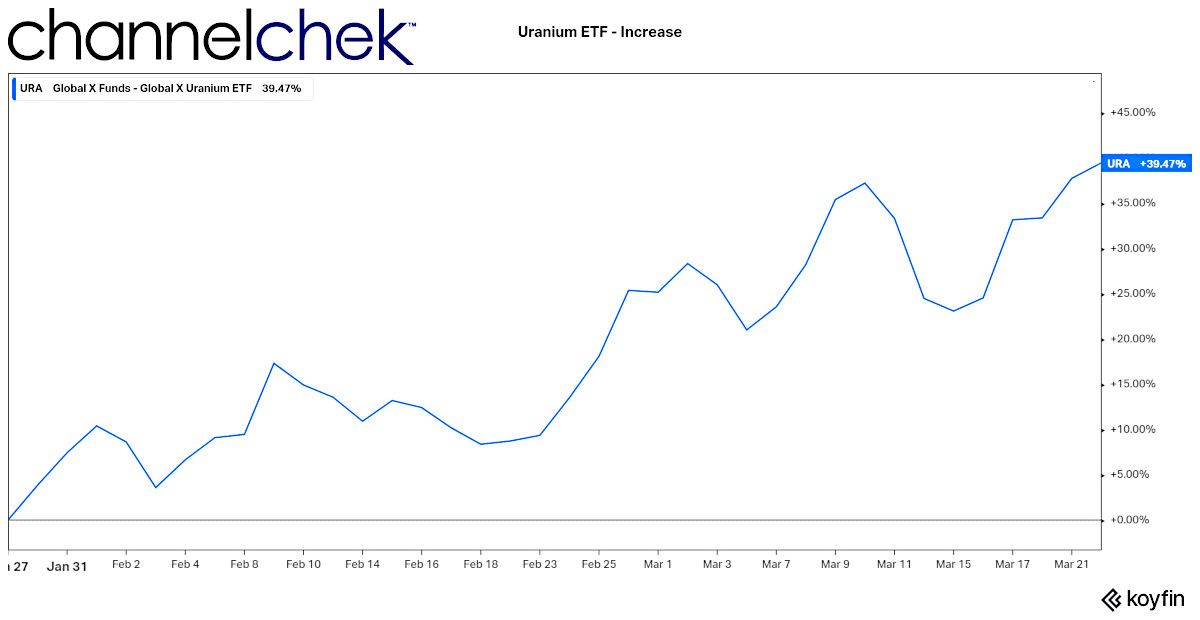 Using $URA as price proxy, Price increase since January 27, 2022
Using $URA as price proxy, Price increase since January 27, 2022